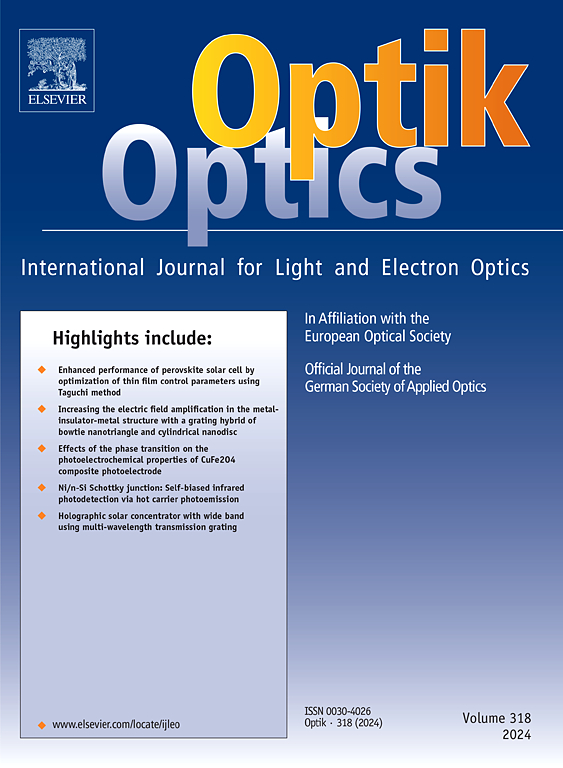Highly sensitive Fano resonance due to coupling between metal-insulator-metal waveguide and semi-ring resonators
IF 3.1
3区 物理与天体物理
Q2 Engineering
引用次数: 0
Abstract
Fano resonance with asymmetric and sharp spectral features has recently been intriguing for refractive index sensing. In this study, we demonstrate a Fano resonance sensor that employs the coupling between a metal-insulator-metal (MIM) waveguide and a semi-ring resonator. The MIM waveguide has a three-ring resonator built in the center, and high-field confinement is observed due to the coupling of the two structures. The coupled structure's transmission spectrum exhibits three Fano resonance modes that are influenced by structure geometry and the surrounding medium's refractive index. The high-quality factor () of mode 3 indicates that this sensor is suitable for use in optical sensing applications. To achieve maximum sensing performance, the parameters of the proposed structure are manipulated and different sensing parameters are computed. The sensor's estimated sensitivity of 3164.97 nm/RIU is equivalent to that of other Fano resonance sensors. Additionally, for plasmonic MIM sensors, the developed sensor achieves high values of and of 5420.99 and 5641.57 , respectively. The proposed high-sensitivity sensor could be an attractive choice for sensing applications because of its straightforward design and ease of fabrication. Also, the combination of very high sensitivity and FOM in a tiny and compact configuration is ideal for on-chip plasmonic nanosensors.
金属-绝缘体-金属波导与半环形谐振器之间耦合的高灵敏度范诺谐振
具有非对称和尖锐光谱特征的法诺共振近年来在折射率传感中引起了人们的兴趣。在这项研究中,我们展示了一种采用金属-绝缘体-金属(MIM)波导和半环形谐振器之间耦合的法诺谐振传感器。MIM波导的中心有一个三环谐振腔,由于两种结构的耦合,观察到高场约束。耦合结构的透射谱表现出三种范诺共振模式,这些模式受结构几何形状和周围介质折射率的影响。模式3的高质量因子(Q−因子)表明该传感器适合用于光学传感应用。为了获得最大的传感性能,对该结构的参数进行了操作,并计算了不同的传感参数。该传感器的估计灵敏度为3164.97 nm/RIU,与其他Fano谐振传感器相当。此外,对于等离子体MIM传感器,所开发的传感器Q−因子和FOM分别达到5420.99和5641.57 RIU−1的高值。所提出的高灵敏度传感器由于其简单的设计和易于制造,可能是传感应用的一个有吸引力的选择。此外,非常高的灵敏度和FOM结合在一个微小和紧凑的配置是理想的片上等离子体纳米传感器。
本文章由计算机程序翻译,如有差异,请以英文原文为准。
求助全文
约1分钟内获得全文
求助全文
来源期刊

Optik
物理-光学
CiteScore
6.90
自引率
12.90%
发文量
1471
审稿时长
46 days
期刊介绍:
Optik publishes articles on all subjects related to light and electron optics and offers a survey on the state of research and technical development within the following fields:
Optics:
-Optics design, geometrical and beam optics, wave optics-
Optical and micro-optical components, diffractive optics, devices and systems-
Photoelectric and optoelectronic devices-
Optical properties of materials, nonlinear optics, wave propagation and transmission in homogeneous and inhomogeneous materials-
Information optics, image formation and processing, holographic techniques, microscopes and spectrometer techniques, and image analysis-
Optical testing and measuring techniques-
Optical communication and computing-
Physiological optics-
As well as other related topics.
 求助内容:
求助内容: 应助结果提醒方式:
应助结果提醒方式:


